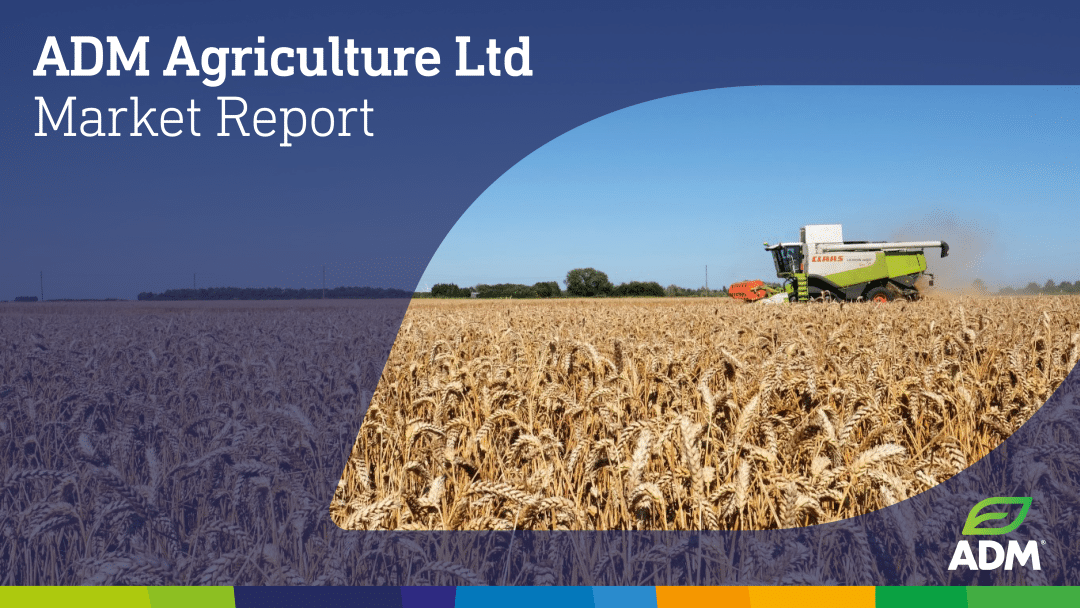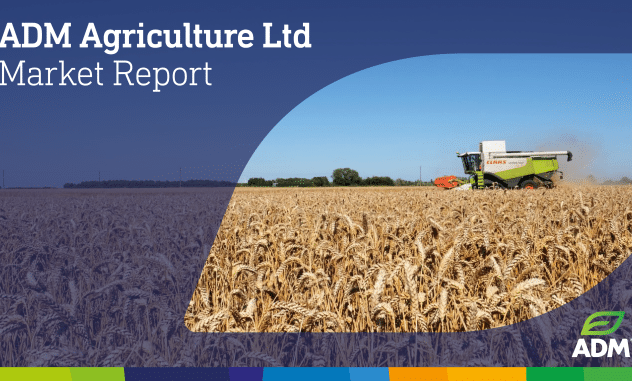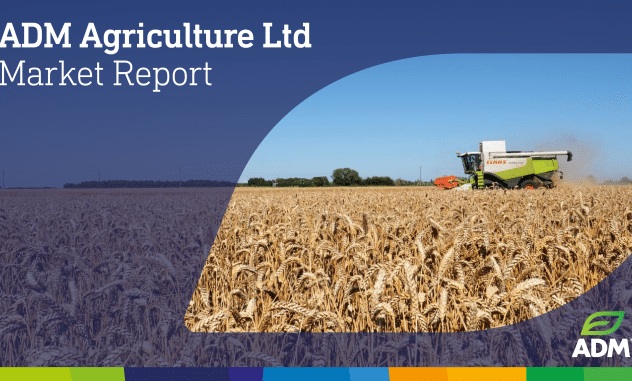WELCOME TO THE ADM AGRICULTURE WEEKLY MARKET REPORT
Wheat
Grain prices rebounded through the week, led by wheat on weather concerns and speculative fund short-covering, while oilseeds faltered on weaker biofuel sentiment. European markets followed US trends, with MATIF wheat hitting 5-week highs. Mixed global weather and export demand shaped sentiment, though questions remain about the rally’s longevity.
Key Factors
- Chicago wheat posted multiple higher closes, breaking technical downtrends with help from lower-than-expected US crop ratings, Chinese drought, and frost damage reports in Russia, triggering aggressive short-covering by funds.
- Soybean oil and crude weakness reversed gains from the bullish WASDE report. A lack of clear direction on US biofuel mandates saw CBOT soybeans fall sharply, with oilseeds under pressure globally.
- Algeria and Saudi Arabia stepped in with major wheat tenders, capitalizing on low prices. This demand helped flip early bearish sentiment, reinforcing the idea that cheap grain is starting to attract buyers.
- MATIF wheat gained €10/t over the week, reacting to Russian frost fears and Northern Europe dryness. UK wheat followed, despite weak export competitiveness, with support from local buying and speculative activity.
- Prior to this week’s rally, Managed money had extended record net short positions across US & European wheat exchanges, leaving markets prone to sharp upward corrections if fundamentals or technical triggers emerge, as seen during this week’s rallies.
Outlook
While this week’s rally brings optimism, its sustainability hinges on weather developments, export continuation, and momentum behind fund buying. With bearish news largely priced in, any further rally requires fresh bullish catalysts—without them, resistance levels may cap gains and European markets may soften if US momentum fades.
Malting Barley
New crop malting barley prices remain steady due to concerns about dry weather, while farmer participation continues to be low. Consumer demand remains weak.
Key Factors
- Dry weather conditions continue to support the new crop values and is holding back any farmer selling, precipitation is forecast for some areas of the UK this weekend and if it materialises would bring some welcome relief to crops.
- Lack of demand from the maltster is keeping markets wide and values nominal.
Outlook
If rain in the forecast arrives then the market could quickly turn back to focusing on demand concerns, but if the dry conditions continue to dominate, prices will stay supported.
Feed Barley
Another slow week for physical barley markets with limited action across both seasons.
Key Factors
- Old crop feels largely done and dusted with few shorts left in the trade and consumers largely covered.
- New crop remains all about farmer selling which is still non-existent as weather forecasts continue to be the focus.
- Export activity is firmly switched off for another week with UK barley a good distance from competitiveness once again.
Outlook
Bottom line, barley remains supported by very limited origination activity but conversely pressured by quiet consumer interest.
Rapeseed
It has been another mixed week with ongoing geopolitical tensions keeping the trade on edge. We have also seen changing weather forecasts help inject some weather premium to both US and EU markets as favourable conditions previously leave plenty of room for risk premium to be added. In the US there is some rain in the forecast which could give us a delay on late planted corn and soybeans which is a particular concern due to the tight stocks that were published on the last USDA WASDE report. We also see some areas of drought in Russia and northern Europe, there is some rainfall in the forecast but possibly not enough to relieve current conditions.
Key Factors
- Week on week, soybeans have gained 3.4 cents so far. Last week there was a selloff on Thursday due to weakness in Soyoil after comments from the EPA administration that a legislative decision on biofuel tax credits and blending mandates could take months, though since this it seems optimism for the long term outlook has returned.
- Crude oil prices have also returned to a similar point to where we were this time last week after a recent selloff due to heavy stocks reports this week, API showing a 2.5 million barrel increase vs. expectations for a 1.3 million barrel cut. There has been some strength on rumours that Israel was preparing to strike Iranian nuclear facilities, though the market quickly reverted to a lower trade. There is also some hope for a potential US/Iran deal which would free up Iranian crude to the market again.
- It has been a quieter week in Canada with markets shut on Monday for a public holiday, though we have seen the inverse into new crop come in slightly. There are some scattered showers expected across Saskatchewan, though plantings are still expected to be around 50-55% which is ahead of the usual pace. For now the uptrend is slowly continuing but is slowing down.
- MATIF rapeseed has remained choppy, though prices do seem to have found some support above €480, the main focus remains on yield potential for now, which we have seen a reduction in the potential Ukrainian figure as well as some concern for northern European regions due to dryness, though sporadic showers are keeping this suppressed for now in terms of risk premium added to price. For now it seems that the choppy trace will continue, which we do usually see this time of year, before we start to see new crop trading in a real fashion.
Overall
As you would expect for this time of year, the main focus will be on weather patterns and the yield potential in Europe as well as the planting campaign in the US/Canada. The change this week is that we have seen some upside due to changing weather forecasts in a market that previously didn’t have any weather premium. This means there is now something that can be taken away, though there is also upside potential if we do see a reduction in potential for the coming crop as well as any sign of delay ahead of harvest.
Oats
The European oat market continues to see minimal farmer selling with growers concerned about crop production due to the lack of rainfall, however this is sparking the interest from consumers to buy and so supporting prices.
Key Factors
- Another week of below normal rainfall in most of the key European oat growing areas, with only pockets in the east of Sweden, Spain and Southern France getting much relief. Germany, the UK and large areas of France, Sweden and Finland had well below average rainfall over the last 7 days. The UK and Germany saw less than 5% of average rainfall in large areas which was a concern.
- The next 7 days is forecast to bring some much needed moisture relief for the developing oat crops in the UK, Sweden, Finland and Northern Germany. However much more consistent rain will be needed to help the spring crops achieve close to their potential.
- Spain is due to get a week of warm dry weather which will help grain fill and add to the crops potential.
- Here in the UK the dryness is becoming an ever increasing concern with parts of the country close to or in drought. There is rain in the forecast but large parts of East Anglia and the Midlands are not going to get above average rainfall over the next 7 days according to European models.
- New crop has been trading as retail customers look to cover positions following the dry weather concerns. Although merchants are becoming hesitant of selling much more given the stress crops are under.
- Prices have stabilised following this extended dry weather period and more rain will be needed to ease the concerns which are building.
Outlook
The lack of rainfall experienced in large parts of northern Europe is continuing to cause buyers concern and leading them to cover positions, therefore with a lack of farmer selling prices are being supported.
Pulses
With continued dry weather and cheap proteins available aplenty, the pulse market has remained quiet this week on the feed side. Human consumption markets are similarly quiet as the old crop campaign is all but over, and we’re still too far away from new crop for consumers or producers alike to see much activity.
Key Factors
- Old crop pulses are now almost done, with little interest aside from the odd top up here and there. Consumers are starting to turn their gaze towards new crop, however it is a little early for pulses to start to engage, especially with the recent dry weather we have had resulting in production concerns. However, it is too early to be writing off this crop, as beans are proving resilient, and rainfall is in the forecast.
- Beans are broadly noncompetitive at this stage in to new crop diets. Compared to imported feed stuffs such as Soymeal and Rapeseed Meal, feed beans are c. £45-50/mt too expensive to be buying wholesale demand in diets across the piece. Realistically, we need to see feed beans devalue £20-25/mt to start picking up some niche demand, which is all that is required, unless we have an absolute barn-buster of a crop. Equally, new crop Baltic beans have also started to trade, and are a discount vs UK origin – further supporting the requirement to come lower.
- Finally, in a change to the tone of the last few weeks, it looks like a reprieve is on the cards for the weather. Pulses have proved comparatively resilient to the prolonged dryness, however they are in need of some moisture to achieve their potential, with winter beans noticeably shorter than usual. However, all is not lost, and they still have plenty of time to make up on lost ground – remember some people were still drilling spring beans at the start of May last year!
- I think it’s safe to say new crop peas could do with some rain in the next week or so which we hope to receive this week. The market is still trying to ascertain the impact of differing trade flows and possible extensions to imports into India but values are being monitored and it’s just a matter of time before we start seeing buyers starting to cover nearby requirements.
Outlook
Whilst the rain dances seem to have been working in some regions, the UK needs to see more consistent rain across the entire area. With a more favourable outlook on the weather, if the forecasted rains come to fruition, this could well lift the crop. Pulses have been more resilient than the cereals until this point, so any rain will be a welcome reprieve before too much damage has been done. The trade will be focusing on primarily the yield potential, although quality discussions will no doubt start to build in the coming weeks also. With imported proteins currently pricing so aggressively for the forward runs, feed grade pulses have a lot of work to do to the downside if they are to compete.
PGRO membership provides valuable pulse agronomy resources and advisory support, with users of the PGRO resources often seeing improved yields.
Seed
With rain in the forecast for the bank holiday weekend, both Spring and Winter crops will get a much needed drink. On more fertile land, wheat appears to be doing well with crops processing at a rapid rate.
Key Factors
- Looking ahead to Autumn, it is without doubt SY Cheer, LG Beowulf and Bamford will be favourites once again. Performing well on farm, allowing maximum return on investment.
- Winter Barley varieties LG Caravelle and LG Capitol are our go to feed barely choices this year with outstanding yield performance and still the ideal crop for entry into OSR.
- Mascani is still the top choice for Winter Oats, available alongside a buyback at ADM.
- There are some new and exciting OSR varieties hitting the market this year both candidates and fully approved, including Karat, Maverick, Hinsta and the new clubroot variety Crusoe. We are also pleased to offer establishment schemes and sale or return options on a range of our OSR varieties helping balance risk management. This is limited so it is important to book soon to avoid disappointment.
- Maize seed is getting limited due to the time of year, however we do have varieties available for fast delivery if you are in need of a top up.
Outlook
Varietal choice is key when optimising success for the coming season and at ADM Agriculture we are here to support you through the decision making process. We have a range of market leading buyback offerings available alongside our seed this year, get in touch with your Farm Trader to find out more.
Our seed specialists are on hand to help with any queries you may have, call our friendly team on 01427 421200, option 5 or speak with your Farm Trader.
| £/€ | £/$ | €/$ |
|---|---|---|
| 1.1839 | 1.3416 | 1.1328 |
| Feed Barley £ | Wheat £ | Beans £ | Oilseed Rape £ | |
|---|---|---|---|---|
| May25 | 145-155 | 165-175 | 210-220 | 430-435 |
NB: Prices quoted are indicative only at the time of going to press and subject to location and quality.
Although ADM Agriculture takes steps to ensure the validity of all information contained within the ADM Agriculture Market Report, it makes no warranty as to the accuracy or completeness of such information. ADM Agriculture will have no liability or responsibility for the information or any action or failure to act based upon such information. ADM Agriculture cannot accept liability arising from errors or omissions in this publication. ADM Agriculture trade under AIC contracts which incorporate the arbitration clause. Terms and Conditions of Purchase.
On every occasion, without exception, grain and pulses will be bought by incorporating by reference the terms & conditions of the AIC No.1 Grain and Peas or Beans contract applicable on the date of the transaction. Also, we will always, and without exception, buy oilseed rape and linseed by incorporating by reference the terms & conditions of the respective terms of the FOSFA 26A and the FOSFA 9A contracts applicable on the date of the transaction. It is a condition of all such transactions that the seller is deemed to know, accept and understand the terms and conditions of each of the above contracts.



